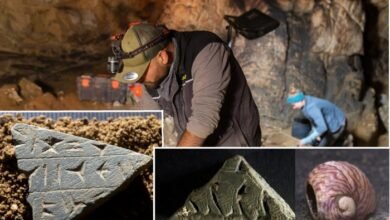Viking Cemetery In Lutomiersk And DNA May Solve The Mystery Of Norse Warriors In Central Poland

Jan Bartek – AncientPages.com – A recent study has uncovered that the early medieval cemetery in Lutomiersk near Lódz in Poland served as a burial site for Norse warriors, as confirmed by genetic analyses of the remains.
This research was carried out by anthropologists and geneticists from the University of Lódz. The discovery, recognized within the scientific community as “sensational,” could pave the way for further investigations to understand how Vikings came to be present in central Poland.
Credit: Pixabay – Public Domain
“Lutomiersk has always piqued our interest. The opportunity to explore these burials arose from the repeated analysis of archaeological materials from this site conducted by Professor Ryszard Grygiel. His excellent study on the early medieval centers of the early Piast state in this part of Poland was instrumental,” said Professor Wieslaw Lorkiewicz from the Department of Anthropology at the Faculty of Biology and Environmental Protection, who has mainly focused on researching skeletons from ancient human populations in the Kujawy region.
Dr. Paulina Borówka from the same department has noted that during the Viking Age, there were multiple waves of Scandinavian settlements in Poland. However, these recent findings represent the first evidence of such settlements discovered in this particular region of the country.
“The most important mystery is how these settlers got here, and my task is to solve it—not based on indirect archaeological data, but genetic data. I addressed this in my doctoral thesis, combining current information on the Lutomier cemetery with the results of our research,” she explained.
For researchers of the history of the early Middle Ages, Lutomiersk is one of the most important sites on the archaeological map of central Poland. There is a cemetery from the first half of the 11th century, where burials were discovered in the 1940s, differing in the form of the grave and equipment from others characteristic of this region of the country. “The cemetery in Lutomiersk is mainly, as it is called in archaeology, a skeletal cemetery where uncremated bodies were buried. They were discovered by accident at the end of World War II,” explained Dr. Borówka.
Following the war, a team of Lódz archaeologists, under Professor Konrad Jazdzewski’s leadership, initiated research in the region. Their findings revealed that the graves were richly furnished with various imports, likely originating from Scandinavian-Russian sources. This site was groundbreaking as it was the first of its kind in this part of Poland to be interpreted as direct evidence of Scandinavian presence—specifically, that of the Varangians. These Scandinavians had settled in areas that later became Kievan Rus during the era of the first Piast dynasty.
The involvement of Vikings in Poland and their potential role in establishing what became known as the Polish state under the first Piast dynasty has been a topic of discussion for over a century. Several archaeological sites across Poland are linked to Scandinavian groups within this early Polish state. However, comprehensive studies on such a scale began near Lódz at Lutomiersk with an examination encompassing an entire cemetery, as highlighted by Professor. Lorkiewicz.
Professor Jazdzewski’s team concluded their research in the early 1950s, transferring archaeological materials and bone remains from the Lutomiersk cemetery to the Archaeological and Ethnographic Museum in Lódz. The preserved human skeletal remains underwent an initial study in the 1970s. At that time, it was not anticipated that further insights could be gleaned from these remains.
“The bone remains were poorly preserved due to the unfavorable ground conditions in this region. A dozen or so years ago, when we became interested in DNA research, I thought their poor preservation state made genetic research impossible. Fortunately, in science, you should never say ‘never,'” admitted the scientist.
Over the past 12 years, DNA isolation and analysis research has advanced significantly. Dr. Borówka noted that EU funding from EASI Genomics enabled sample transport between various laboratories. This process allowed DNA extraction from bones to explore historical mysteries. After years of work, scientists in Lódz analyzed DNA from Lutomiersk cemetery remains, revealing high genetic diversity and origins from different populations, including Scandinavian and Slavic descent and mixed ancestry. The study used bones from various cemetery sections, offering a comprehensive view of its historical inhabitants.
“Scandinavian DNA” was found in various parts of the cemetery, indicating that people of such origins played different social roles and stayed in the area long enough for their remains to be found in the necropolis’s older and newer sections.
“The cemetery was not used at just one point in time. Over the years, burials were added in the main alley and outskirts. I tried to select samples for analysis from fragments of available skeletons to reflect this diversity best,” explained Dr. Borówka as explained in a press release.
The identification of Scandinavian origins in the remains found at Lutomiersk is based on comprehensive genetic analysis. Researchers compared these remains with skeletons from other necropolises in Poland and Europe, known to belong to Scandinavian populations, such as those from Cieple in Tczew County. This approach was further supported by data from Margaryan’s extensive archaeogenetic study of Viking burials across Europe.
Genetic studies have confirmed that some individuals buried at the Lutomiersk cemetery share biological connections with Scandinavian populations. This discovery holds significant implications for ongoing archaeological debates regarding the origins and cultural ties of monuments found in cemeteries like Lutomiersk.
See also: More Archaeology News
However, while these findings provide clarity, they do not fully resolve the mystery of how Vikings reached central Poland. Dr. Borówka highlighted that this is just a step forward; further analyses are planned to deepen our understanding. Isotope studies could help verify theories about these individuals’ geographical origins As research technology advances, new discoveries may emerge from these remains in future years.
Written by Jan Bartek – AncientPages.com Staff Writer





